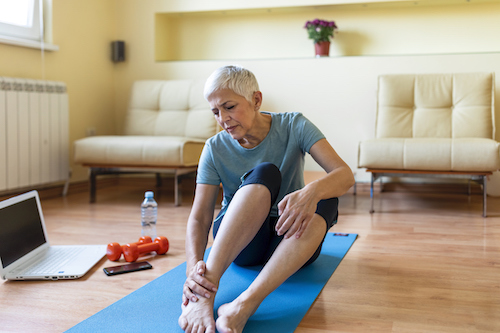Authored by Dr. Pier Boutin, MD
Over the past few months, so many women have come into my clinic complaining of joint pain and swelling. These are new patients who had never experienced joint problems prior to the pandemic, but now find themselves waking up with stiff and aching joints, ankle and hand swelling, and overwhelming fatigue. They don’t understand why their joint health has suddenly taken a turn for the worse.

Although these patients were not infected with Covid-19, their discomfort is undeniably connected to the virus and the stay-at-home ordinances that followed its arrival. When I ask my patients about their lifestyle choices during the pandemic, I often discover that a few specific habits have become part of their daily routines in isolation — increasing their risk of developing inflammatory joint pain.
If you’ve been experiencing new or unexplained aches and pains, ask yourself if the following “pandemic patterns” have recently emerged in your own life:
Change 1: Wine o’clock
Instead of drinking one glass of wine at the end of a long day, many of my patients with new or worsening joint pain have been drinking one to three glasses every night. It’s understandable — these are anxious and uncertain times, and sometimes a good glass of wine calms the mind and helps with falling asleep. Alcohol, especially a glass of low-sulfite red wine, may be a good source of a powerful antioxidant polyphenol called resveratrol. But consuming too much alcohol on a regular basis triggers inflammation and impairs the body’s ability to repair itself, generate new cell growth, and regulate that inflammation — which directly contribute to joint pain and general inflammation throughout the entire body.
Change 2: Sneaky sugar
Toilet paper hasn’t been the only item in high demand during the pandemic — baker’s yeast and flour are also flying off the shelves at unprecedented rates. Why? Everyone is baking! Although breads, pasta, and white rice are wonderful comfort foods, they also contain compound sugars that cause an extended release of glucose, resulting in stubborn weight gain around the waist. Unfortunately, these adipocytes (fat cells) produce inflammatory cytokines, which can contribute to joint pain and damage. Recent research suggests that these inflammatory cytokines (TNF-alpha and interleukins) are also part of the “cytokine storms” that have been linked to an increased risk of Covid-19 complications.
Change 3: “Stay at home” vs. “sit at home”
Between the bread, wine, stress, and social isolation of the pandemic, many of my patients report feeling lethargic, unmotivated and mildly depressed. When you’re in this state, almost everything feels like a chore — especially exercise. But staying sedentary means that you also miss out on all of the benefits of exercise — which includes burning fat, increasing circulation, and reducing inflammation. Exercise also strengthens the muscles that support your joints; if these muscles aren’t maintained through exercise, the strain and pressure on your joints causes pain and long-term damage. Even just 20 minutes of exercise is enough to make a difference!
3 new patterns to reduce joint pain
Now that we’ve identified the less-than-healthy habits that cause inflammation and joint pain (seronegative joint inflammation), it’s time to reverse the inflammatory chain reaction. With just three simple changes, my patients are feeling healthier and happier at home. Here’s how to get started:
Healthy habit #1: Balance blood sugar
Let’s be honest: sugar provides very few benefits to your physical health. Unfortunately, sugar is used in the vast majority of processed foods — even foods that don’t taste sweet, like ketchup and macaroni & cheese. Here are my tips to avoid the sugar trap:
- Always read the ingredients labels, and keep an eye out for sugar and the many aliases it hides behind: agave, maltodextrin, dextrose, and more.
- Focus on filling your plate with healthy, whole foods. Include vegetables with every meal, with the largest portion of vegetables at dinner time.
- Start with small changes, like replacing your glass of wine with a soothing mug of herbal tea in the evening.
- Breakfast can be challenging, as typical breakfast foods like cereals, pancakes, donuts, and toast are all packed with sugar. Try a high-protein replacement to balance blood sugar and prevent cravings: eggs, black beans, protein shakes, and quinoa with avocado are all delicious and nutritious alternatives.
- Bread, wine, and dessert have become a normal part of our dinner routines — which can leave you feeling foggy, bloated, and craving sugar the next morning. Try to eliminate at least one of the top three offenders from your dinner routine (bonus points for eliminating all three at once!) You may be surprised to find that filling up on a healthy protein — fish, lamb, organic chicken, tofu, etc. — and vegetables will reduce your dependence on sweets and the inevitable blood sugar crash that results.
Healthy habit #2: Get moving
A brisk walk right after dinner improves digestion and glucose metabolism, and keeps you away from the dessert table. However, the easiest way to control and reduce inflammation is through sustained aerobic exercise for 20-30 minutes per day, 3-5 days per week. Aim to get your heart rate up to the point where it would be challenging to carry a conversation. Cardiac patients should receive their doctor’s authorization prior to this kind of exercise.
Healthy habit #3: Support your body through temporary detox discomfort
I always want my patients to know that switching to an anti-inflammatory lifestyle and diet can lead to sudden weight loss. As fat cells dissolve, stored proinflammatory cytokines are released into the bloodstream. This means that in the first few weeks of eating this way, depending on the amount of weight loss, patients may feel worse instead of better — and continue to experience joint pain until the inflammation lowers. This is why you really want to work with your healthcare practitioner during this time of change for encouragement, diet review and recipe suggestions. You may also consider taking an antioxidant supplement to help the body better cope with oxidative stress. But the benefits of an anti-inflammatory lifestyle and diet outweigh the initial discomfort of detox. In fact, studies show that people who follow an anti-inflammatory diet live longer, more active lives with reduced risk of developing cancer, diabetes and heart disease.
While we’re all well aware of the risks of Covid-19 infection, it’s also important to recognize the pandemic’s impact on our lifestyles and daily habits. If you are currently experiencing joint pain, consider it a warning sign that it’s time to dig deep and shift your habits now to ensure your joints will be able to support your healthy, active life — during the pandemic and beyond.
 |
What’s causing your joint pain? Find out if you should be worried about your symptoms. |
Last updated on 10/19/2020









